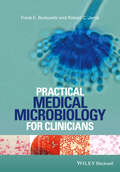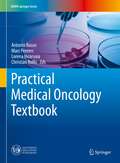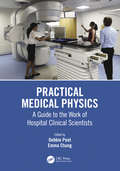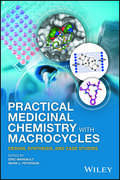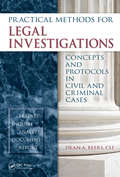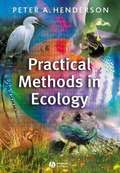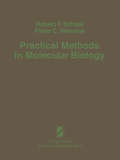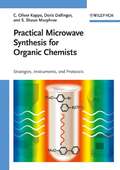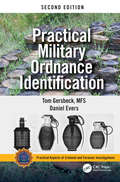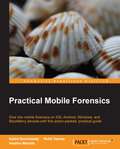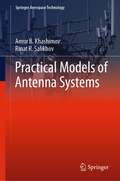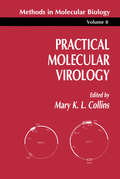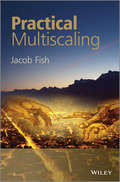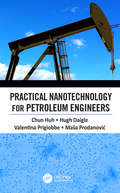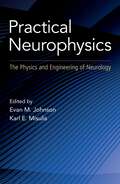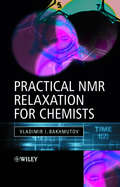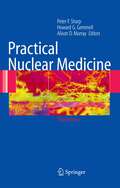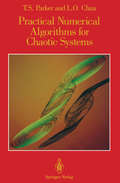- Table View
- List View
Practical Medical Microbiology for Clinicians
by Frank E. Berkowitz Robert C. JerrisInfectious diseases constitute a major portion of illnesses worldwide, and microbiology is a main pillar of clinical infectious disease practice. Knowledge of viruses, bacteria, fungi, and parasites is integral to practice in clinical infectious disease. Practical Medical Microbiology is an invaluable reference for medical microbiology instructors. Drs. Berkowitz and Jerris are experienced teachers in the fields of infectious diseases and microbiology respectively, and provide expert insight into microorganisms that affect patients, how organisms are related to each other, and how they are isolated and identified in the microbiology laboratory. The text also is designed to provide clinicians the knowledge they need to facilitate communication with the microbiologist in their laboratory. The text takes a systematic approach to medical microbiology, describing taxonomy of human pathogens and consideration of organisms within specific taxonomic groups. The text tackles main clinical infections caused by different organisms, and supplements these descriptions with clinical case studies, in order to demonstrate the effects of various organisms. Practical Medical Microbiology is an invaluable resource for students, teachers, and researchers studying clinical microbiology, medical microbiology, infectious diseases, and virology.
Practical Medical Microbiology for Clinicians
by Frank E. Berkowitz Robert C. JerrisInfectious diseases constitute a major portion of illnesses worldwide, and microbiology is a main pillar of clinical infectious disease practice. Knowledge of viruses, bacteria, fungi, and parasites is integral to practice in clinical infectious disease. Practical Medical Microbiology is an invaluable reference for medical microbiology instructors. Drs. Berkowitz and Jerris are experienced teachers in the fields of infectious diseases and microbiology respectively, and provide expert insight into microorganisms that affect patients, how organisms are related to each other, and how they are isolated and identified in the microbiology laboratory. The text also is designed to provide clinicians the knowledge they need to facilitate communication with the microbiologist in their laboratory. The text takes a systematic approach to medical microbiology, describing taxonomy of human pathogens and consideration of organisms within specific taxonomic groups. The text tackles main clinical infections caused by different organisms, and supplements these descriptions with clinical case studies, in order to demonstrate the effects of various organisms. Practical Medical Microbiology is an invaluable resource for students, teachers, and researchers studying clinical microbiology, medical microbiology, infectious diseases, and virology.
Practical Medical Oncology Textbook (UNIPA Springer Series)
by Antonio Russo Christian Rolfo Marc Peeters Lorena IncorvaiaThis textbook combines essential information on clinical cancer medicine with a guide to the latest advances in molecular oncology and tumor biology. Providing a systematic overview of all types of solid tumors, including epidemiology and cancer prevention, genetic aspects of hereditary cancers, differential diagnosis, typical signs and symptoms, diagnostic strategies and staging, and treatment modalities, it also discusses new and innovative cancer treatments, particularly targeted therapy and immunotherapy. Expert commentaries at the end of each chapter highlight key points, offer insights, suggest further reading and discuss clinical application using case descriptions. This textbook is an invaluable, practice-oriented tool for medical students just beginning their clinical oncology studies, as well as for medical oncology residents and young professionals.
Practical Medical Physics: A Guide to the Work of Hospital Clinical Scientists
by Debbie PeetThis is the first all-encompassing textbook designed to support trainee clinical scientists in medical physics as they start work in a hospital setting whilst undertaking an academic master’s course. Developed by practising physicists and experienced academics using their experience of teaching trainee medical physicists, this book provides an accessible introduction to the daily tasks that clinical scientists perform in the course of their work. It bridges the gap between theory and practice, making the book also suitable for advanced undergraduate and graduate students in other disciplines studying modules on medical physics, including those who are considering a career in medical physics through applying to the NHS Scientist Training Programme (STP). Features: Provides an accessible introduction to practical medical physics within a hospital environment Maps to the course content of the Scientist Training Programme in the NHS Acts as a complement to the academic books often recommended for medical physics courses
Practical Medical Physics: A Guide to the Work of Hospital Clinical Scientists
by Debbie Peet Emma ChungThis is the first all-encompassing textbook designed to support trainee clinical scientists in medical physics as they start work in a hospital setting whilst undertaking an academic master’s course. Developed by practising physicists and experienced academics using their experience of teaching trainee medical physicists, this book provides an accessible introduction to the daily tasks that clinical scientists perform in the course of their work. It bridges the gap between theory and practice, making the book also suitable for advanced undergraduate and graduate students in other disciplines studying modules on medical physics, including those who are considering a career in medical physics through applying to the NHS Scientist Training Programme (STP). Features: Provides an accessible introduction to practical medical physics within a hospital environment Maps to the course content of the Scientist Training Programme in the NHS Acts as a complement to the academic books often recommended for medical physics courses
Practical Medicinal Chemistry with Macrocycles: Design, Synthesis, and Case Studies
by Eric Marsault Mark L. PetersonIncluding case studies of macrocyclic marketed drugs and macrocycles in drug development, this book helps medicinal chemists deal with the synthetic and conceptual challenges of macrocycles in drug discovery efforts. Provides needed background to build a program in macrocycle drug discovery –design criteria, macrocycle profiles, applications, and limitations Features chapters contributed from leading international figures involved in macrocyclic drug discovery efforts Covers design criteria, typical profile of current macrocycles, applications, and limitations
Practical Medicinal Chemistry with Macrocycles: Design, Synthesis, and Case Studies
by Eric Marsault Mark L. PetersonIncluding case studies of macrocyclic marketed drugs and macrocycles in drug development, this book helps medicinal chemists deal with the synthetic and conceptual challenges of macrocycles in drug discovery efforts. Provides needed background to build a program in macrocycle drug discovery –design criteria, macrocycle profiles, applications, and limitations Features chapters contributed from leading international figures involved in macrocyclic drug discovery efforts Covers design criteria, typical profile of current macrocycles, applications, and limitations
Practical Methods for Legal Investigations: Concepts and Protocols in Civil and Criminal Cases
by CLI, Dean BeersLegal investigators are responsible for providing factual evidence � as the fact finders, they are the foundation for the attorneys they work with daily. The attorney is responsible for forming and implementing the legal strategy and presenting it to the judge or jury. The legal investigator provides checks and balances to ensure that no evidence i
Practical Methods in Ecology
by Peter A. HendersonThere are few books available that provide a good introduction to the methods and techniques for ecological research. This book will be invaluable to lecturers teaching field courses and students undertaking project work in ecology. Each chapter will focus on an ecological technique. It will have an introductory section that describes the ecological principles and theory. This will then be followed by example applications. These will focus on three most common habitats where teachers take students for fieldwork; the seashore, ponds and lakes, fields and woodland. Gives specific worked examples from the main ecosystems used for undergraduate study - seashore, lakes/ponds, field and woodland. Only introductory text specifically focused on field techniques. Great 'how-to' guide that will show student exactly how to carry out each method. Only text to emphasise the principles behind the techniques - taking a methods based approach rather than a taxonomic approach (eg chapters split into population measures, biodiversity measures, species richness measures rather than methods for invertebrates, methods for mammals, methods for birds etc). Greater emphasis on the equipment involved - how to make it, where to buy it. Good references to further reading and advanced techniques.
Practical Methods in Molecular Biology
by Robert F. Schleif Pieter C. WensinkThis volume has evolved from a laboratory methods book that one of us first compiled nearly fifteen years ago. Since that time the book has undergone many minor revisions in order to include new methods and updated versions of older methods. The result has been an increasingly useful and more widely circulated book. However, the recent series of technological explosions generally lumped together under the name of "recombinant DNA technology" has been a turning point in the evolution of this previously underground publication. Minor revisions will no longer do. To keep the book useful we have had to make major revi sions and additions. The result is a dramatically expanded book that should be more useful to more people. The larger size and wider usefulness of the book have made this more formal publication seem a reasonable step to take. One of the reasons that this volume should be useful to many people is that it includes only procedures that have been used repeatedly by us and that have proven highly reliable both to ourselves and to others in our laboratories.
Practical Microwave Synthesis for Organic Chemists: Strategies, Instruments, and Protocols
by C. Oliver Kappe Doris Dallinger Shaun S. MurphreeWith the novice user in mind, this beginner's guide explains the basics behind microwave technology, evaluates available instruments and reaction modes, and provides practical hints for every eventuality. Includes 27 detailed protocols for often-used reactions. From the contents: 1 Microwave Synthesis - An Introduction 2 Microwave Theory 3 Equipment Review 4 Microwave Processing Techniques 5 Starting With Microwave Chemistry 6 Experimental Protocols 6.1 General Small-Scale Sealed-Vessel Microwave Processing 6.2 Reaction Optimization 6.3 Library Generation 6.4 Reaction Scale-Up 6.5 Special Processing Techniques
Practical Military Ordnance Identification, Second Edition (Practical Aspects of Criminal and Forensic Investigations)
by Thomas GersbeckThe threat variables associated with military ordnance are enormous, requiring the application of a structured process to identify unknown munitions. The focus of Practical Military Ordnance Identification, Second Edition is the application of a practical deductive process to identify unknown ordnance items that are commonly recovered outside military control. The author supplies a seven-step procedure to identify unknown munitions by their category, group, and type. Detailed logic trees help users narrow down the possibilities in order to accurately identify ordnance. The book covers the safety precautions associated with each category and group of ordnance. It describes many ordnance construction characteristics and explains the fundamentals of military ordnance fuzing. Appendices define terms and supply abbreviations and acronyms used to describe military ordnances. Coverage new to this edition include: a list of conventional markings; additional safety precautions to take; an expanded list of high explosives; additional technical details on explosives effects; hazards associated with pyrotechnics, pyrophorics, smoke compounds, and incendiaries; a section on pre-1870 projectiles, hand grenades, landmines, underwater ordnances, and rockets; and details on Man-Portable-Air-Defense-Systems (MANPADS) missile systems.
Practical Military Ordnance Identification, Second Edition (Practical Aspects of Criminal and Forensic Investigations #59)
by Thomas GersbeckThe threat variables associated with military ordnance are enormous, requiring the application of a structured process to identify unknown munitions. The focus of Practical Military Ordnance Identification, Second Edition is the application of a practical deductive process to identify unknown ordnance items that are commonly recovered outside military control. The author supplies a seven-step procedure to identify unknown munitions by their category, group, and type. Detailed logic trees help users narrow down the possibilities in order to accurately identify ordnance. The book covers the safety precautions associated with each category and group of ordnance. It describes many ordnance construction characteristics and explains the fundamentals of military ordnance fuzing. Appendices define terms and supply abbreviations and acronyms used to describe military ordnances. Coverage new to this edition include: a list of conventional markings; additional safety precautions to take; an expanded list of high explosives; additional technical details on explosives effects; hazards associated with pyrotechnics, pyrophorics, smoke compounds, and incendiaries; a section on pre-1870 projectiles, hand grenades, landmines, underwater ordnances, and rockets; and details on Man-Portable-Air-Defense-Systems (MANPADS) missile systems.
Practical Mobile Forensics
by Satish Bommisetty Rohit Tamma Heather MahalikThe book is an easy-to-follow guide with clear instructions on various mobile forensic techniques. The chapters and the topics within are structured for a smooth learning curve, which will swiftly empower you to master mobile forensics. If you are a budding forensic analyst, consultant, engineer, or a forensic professional wanting to expand your skillset, this is the book for you. The book will also be beneficial to those with an interest in mobile forensics or wanting to find data lost on mobile devices. It will be helpful to be familiar with forensics in general but no prior experience is required to follow this book.
Practical Models of Antenna Systems (Springer Aerospace Technology)
by Amur B. Khashimov Rinat R. SalikhovThis book discusses the principles of forming and analysis of mathematical models of a wide class of antenna systems, new scientific directions in the development and application of computational algorithms for the study of mathematical models for antenna arrays of radio navigating systems. The book is presented for specialists in antenna system design; it may be useful for students of radio engineering specialties. This book consequentially uses the asymptotic correspondence of two-dimensional and three-dimensional problems to antenna engineering, that includes the influence of the placement objects for a given limited class of problems. Rigorous electrodynamics formulations of models and the use of efficient numerical methods provide the reliability and accuracy of modeling.
Practical Multiscaling
by Jacob FishPractical Multiscaling covers fundamental modelling techniques aimed at bridging diverse temporal and spatial scales ranging from the atomic level to a full-scale product level. It focuses on practical multiscale methods that account for fine-scale (material) details but do not require their precise resolution. The text material evolved from over 20 years of teaching experience at Rensselaer and Columbia University, as well as from practical experience gained in the application of multiscale software. This book comprehensively covers theory and implementation, providing a detailed exposition of the state-of-the-art multiscale theories and their insertion into conventional (single-scale) finite element code architecture. The robustness and design aspects of multiscale methods are also emphasised, which is accomplished via four building blocks: upscaling of information, systematic reduction of information, characterization of information utilizing experimental data, and material optimization. To ensure the reader gains hands-on experience, a companion website hosting a lite version of the multiscale design software (MDS-Lite) is available. Key features: Combines fundamental theory and practical methods of multiscale modelling Covers the state-of-the-art multiscale theories and examines their practical usability in design Covers applications of multiscale methods Accompanied by a continuously updated website hosting the multiscale design software Illustrated with colour images Practical Multiscaling is an ideal textbook for graduate students studying multiscale science and engineering. It is also a must-have reference for government laboratories, researchers and practitioners in civil, aerospace, pharmaceutical, electronics, and automotive industries, and commercial software vendors.
Practical Multiscaling
by Jacob FishPractical Multiscaling covers fundamental modelling techniques aimed at bridging diverse temporal and spatial scales ranging from the atomic level to a full-scale product level. It focuses on practical multiscale methods that account for fine-scale (material) details but do not require their precise resolution. The text material evolved from over 20 years of teaching experience at Rensselaer and Columbia University, as well as from practical experience gained in the application of multiscale software. This book comprehensively covers theory and implementation, providing a detailed exposition of the state-of-the-art multiscale theories and their insertion into conventional (single-scale) finite element code architecture. The robustness and design aspects of multiscale methods are also emphasised, which is accomplished via four building blocks: upscaling of information, systematic reduction of information, characterization of information utilizing experimental data, and material optimization. To ensure the reader gains hands-on experience, a companion website hosting a lite version of the multiscale design software (MDS-Lite) is available. Key features: Combines fundamental theory and practical methods of multiscale modelling Covers the state-of-the-art multiscale theories and examines their practical usability in design Covers applications of multiscale methods Accompanied by a continuously updated website hosting the multiscale design software Illustrated with colour images Practical Multiscaling is an ideal textbook for graduate students studying multiscale science and engineering. It is also a must-have reference for government laboratories, researchers and practitioners in civil, aerospace, pharmaceutical, electronics, and automotive industries, and commercial software vendors.
Practical Nanotechnology for Petroleum Engineers
by Chun Huh Hugh Daigle Valentina Prigiobbe Masa ProdanovicThis book is a concise but well-organized introduction to nanotechnology (NT) which the upstream oil industry is now vigorously adapting to develop its own unique applications for improved oilfield operations and, oil and gas production. Its reader will learn nanotechnology fundamentals, be introduced to important NT products and applications from other industries and learn about the current state of development of various NT applications in the upstream oil industry, which include innovative use of nanoparticles for enhanced oil recovery; drilling and completions; reservoir sensing; and production operations and flow assurance. Key Features Exclusive title on potential of nanoparticle-based agents and interventions for improving myriad of oilfield operations Unique guide for nanotechnology applications developers and users for oil and gas production Introduces nanotechnology for oil and gas managers and engineers Includes research data discussions relevant to field Offers a practical applications-oriented approach
Practical Nanotechnology for Petroleum Engineers
by Chun Huh Hugh Daigle Valentina Prigiobbe Masa ProdanovicThis book is a concise but well-organized introduction to nanotechnology (NT) which the upstream oil industry is now vigorously adapting to develop its own unique applications for improved oilfield operations and, oil and gas production. Its reader will learn nanotechnology fundamentals, be introduced to important NT products and applications from other industries and learn about the current state of development of various NT applications in the upstream oil industry, which include innovative use of nanoparticles for enhanced oil recovery; drilling and completions; reservoir sensing; and production operations and flow assurance. Key Features Exclusive title on potential of nanoparticle-based agents and interventions for improving myriad of oilfield operations Unique guide for nanotechnology applications developers and users for oil and gas production Introduces nanotechnology for oil and gas managers and engineers Includes research data discussions relevant to field Offers a practical applications-oriented approach
Practical Neurophysics: The Physics and Engineering of Neurology
by Evan M. Johnson and Karl E. MisulisPractical Neurophysics: The Physics and Engineering of Neurology explores and explains the physical foundations of neurology with a principal focus on the technologies that we use for diagnosis and management. The physics of biologic systems is also discussed, in the context of interfacing with our technologies and the mechanisms behind abnormalities. With sections on ultrasound, advanced laboratory tests, and neurotherapeutics, this is a unique book that focuses on the science and engineering rather than on disease processes. This book is intended to give the reader an appreciation of the mechanisms behind our technology and how humans and machines interface. The spectrum of presented information ranges from basic atomic physics to electronics to mechanisms of abnormalities on MRI and EEG. With this book, the reader should have a better understanding of the mechanisms of the technologies we use as well as an understanding of how normal and pathological functioning produces findings we can record.
Practical Neurophysics: The Physics and Engineering of Neurology
Practical Neurophysics: The Physics and Engineering of Neurology explores and explains the physical foundations of neurology with a principal focus on the technologies that we use for diagnosis and management. The physics of biologic systems is also discussed, in the context of interfacing with our technologies and the mechanisms behind abnormalities. With sections on ultrasound, advanced laboratory tests, and neurotherapeutics, this is a unique book that focuses on the science and engineering rather than on disease processes. This book is intended to give the reader an appreciation of the mechanisms behind our technology and how humans and machines interface. The spectrum of presented information ranges from basic atomic physics to electronics to mechanisms of abnormalities on MRI and EEG. With this book, the reader should have a better understanding of the mechanisms of the technologies we use as well as an understanding of how normal and pathological functioning produces findings we can record.
Practical Nuclear Magnetic Resonance Relaxation for Chemists
by Vladimir I. BakhmutovThis book demonstrates how NMR relaxation can be applied for structural diagnostics of chemical compounds, recognition of weak intermolecular interactions, determinations of internuclear distances and lengths of chemical bonds when compounds under investigation can exist only in solutions. Written as a textbook for chemists, demanding little background in physics and NMR Its practical approach helps the reader to apply the techniques in the lab First book to teach NMR Relaxation techniques to chemists
Practical Nuclear Medicine
by Peter F. Sharp Howard G. Gemmell Alison D. MurrayThis book is an essential guide for all practitioners. The emphasis throughout is on the practice of nuclear medicine. Primarily aimed at the radiologist, physician, physicist or technologist starting in nuclear medicine, it will also appeal to more experienced practitioners who are keen to stay up-to-date. The practical approach with tables as "recipes" for acquisition protocols means it is essential for any departmental shelf. 3rd edition expanded - now covering areas of development in nuclear medicine, such as PET and other methods of tumour imaging, data processing. All illustrations are up-to-date to reflect current standards of image quality.
Practical Numerical Algorithms for Chaotic Systems
by Thomas S. Parker Leon ChuaOne of the basic tenets of science is that deterministic systems are completely predictable-given the initial condition and the equations describing a system, the behavior of the system can be predicted 1 for all time. The discovery of chaotic systems has eliminated this viewpoint. Simply put, a chaotic system is a deterministic system that exhibits random behavior. Though identified as a robust phenomenon only twenty years ago, chaos has almost certainly been encountered by scientists and engi neers many times during the last century only to be dismissed as physical noise. Chaos is such a wide-spread phenomenon that it has now been reported in virtually every scientific discipline: astronomy, biology, biophysics, chemistry, engineering, geology, mathematics, medicine, meteorology, plasmas, physics, and even the social sci ences. It is no coincidence that during the same two decades in which chaos has grown into an independent field of research, computers have permeated society. It is, in fact, the wide availability of inex pensive computing power that has spurred much of the research in chaotic dynamics. The reason is simple: the computer can calculate a solution of a nonlinear system. This is no small feat. Unlike lin ear systems, where closed-form solutions can be written in terms of the system's eigenvalues and eigenvectors, few nonlinear systems and virtually no chaotic systems possess closed-form solutions.
